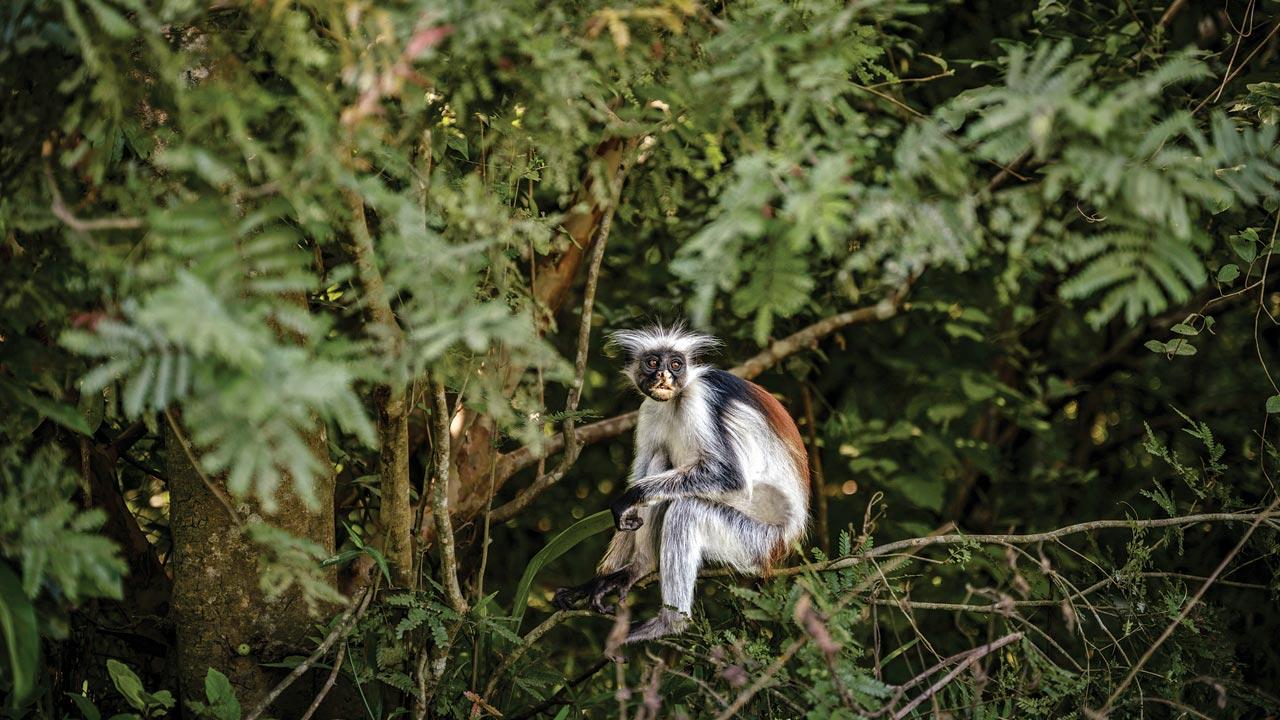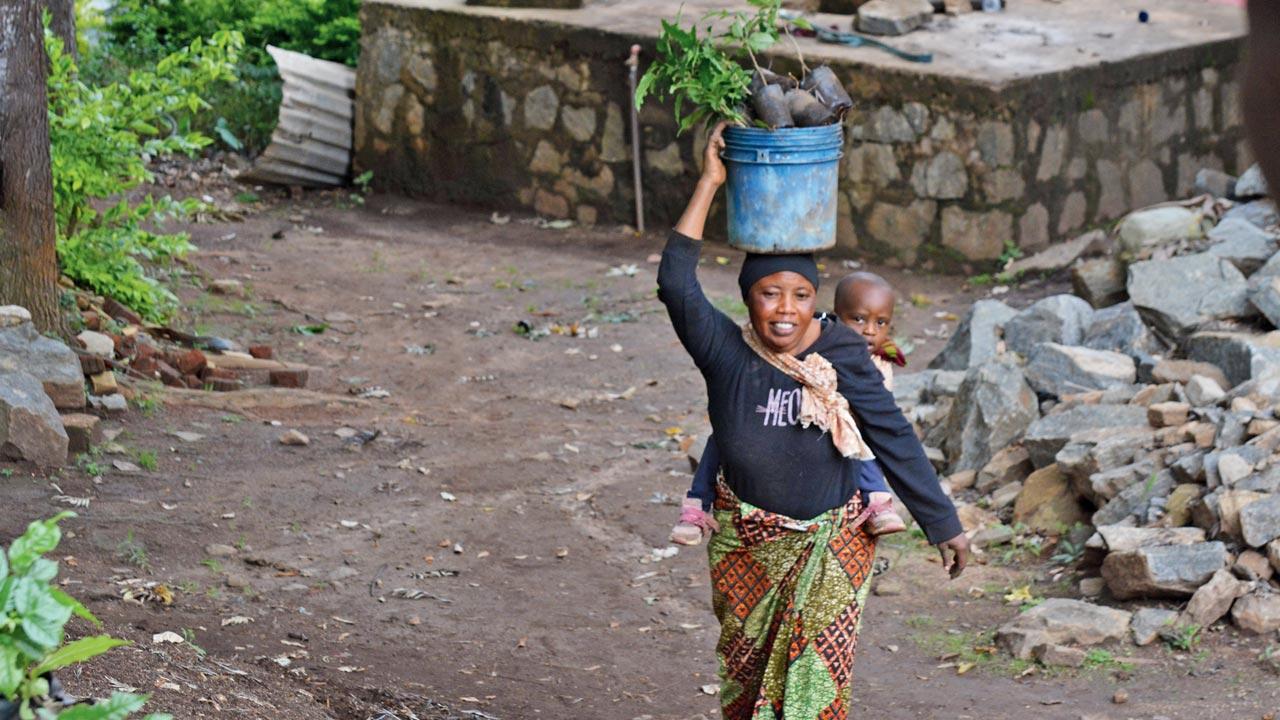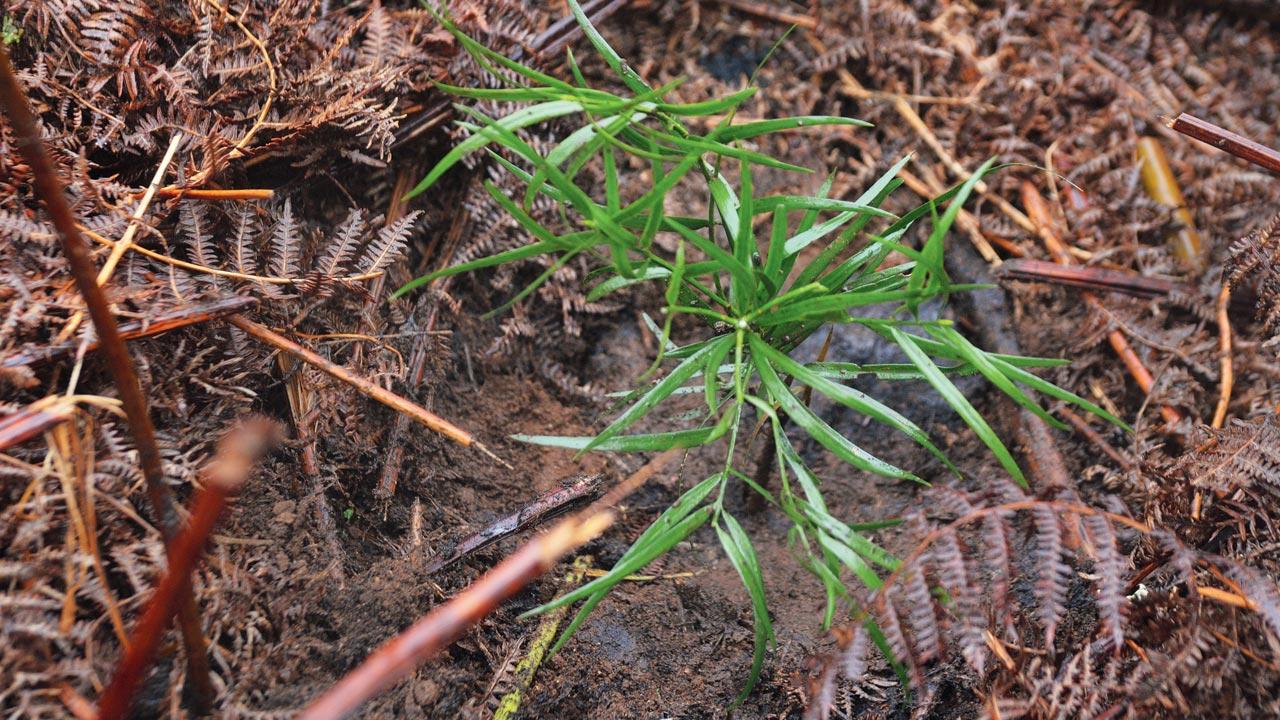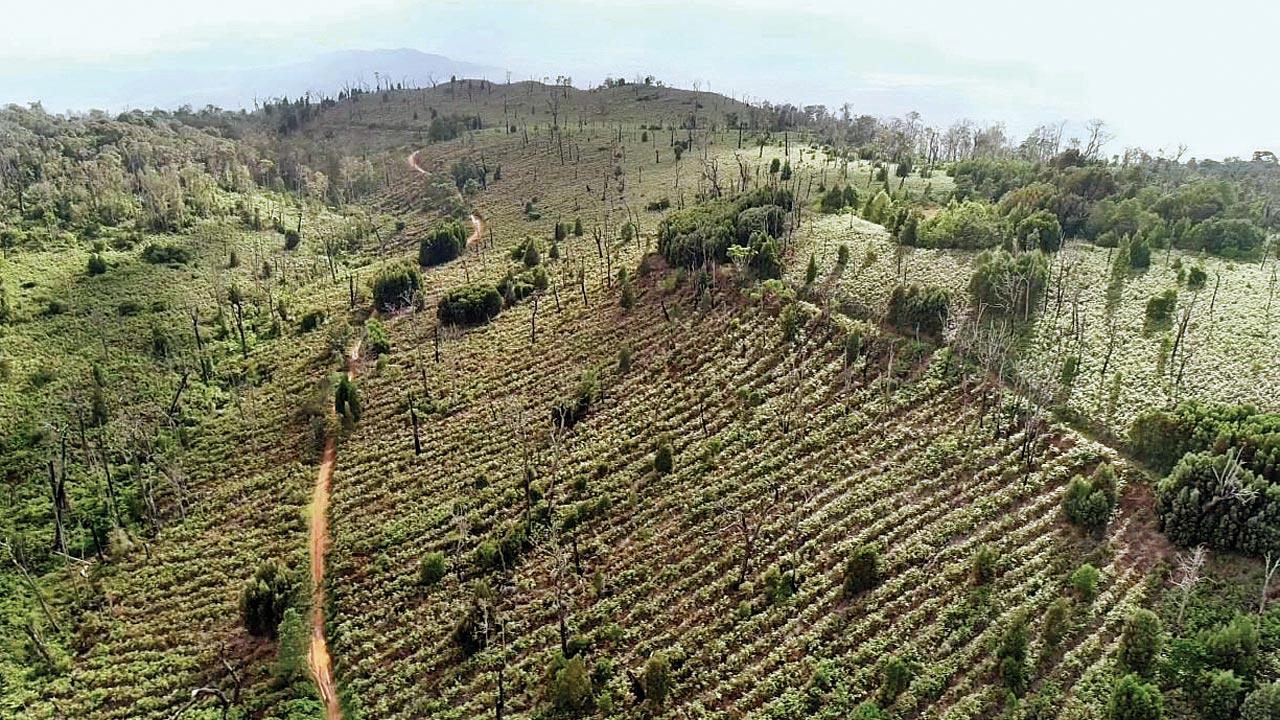The best gift you will give someone costs just hundred bucks and holds the promise to save a threatened primate from extinction

A 2011 photo of a three-week old Colobus monkey at Melbourne Zoo with its mother. Black and White Colobus monkeys are native to Tanzania, Kenya, Angola, Democratic Republic of Congo, Uganda, Rwanda and Burundi, and have seen their numbers drop historically, first for fur trade during colonial times, and now due to loss of habitat and the bushmeat trade. Pic/Getty Images
A glimpse of a bushy white tail and the loud but lyrical rattle echoing through the night forest of Usambara usually meant that the Colubus monkey was nearby. Usambara is home to hills on the 100 km majestic Eastern Arc Mountains that run from eastern Tanzania to Kenya and are the natural habitat of the black and white primate species.
Dating back to a hundred million years, the Eastern Arc Mountains support a habitat that’s fast vanishing, making the International Union for Conservation of Nature (IUCN), considered a global authority on the status of the natural world, classify the species as vulnerable. Living in groups of eight to 12 across east and central Africa, their exact numbers are currently not known although environmentalists are keenly aware of the crisis they have faced for 30 years.
 A recluse of the forest the white and black colobus monkey have been recently found wandering into orchards, trying to eat the produce due to loss of their habitat. Pic/Getty Images
A recluse of the forest the white and black colobus monkey have been recently found wandering into orchards, trying to eat the produce due to loss of their habitat. Pic/Getty Images
In early 2022, when Supriya Patil came across this classification on the IUCN website, her curiosity was piqued. Patil, who holds a degree in environment science from KJ Somaiya, worked with Colaba-headquartered non-profit Grow-Trees.com. The information she had chanced upon was enough to make her research the dangers that the animal was facing; it was also the same species that those of who binged on animal television in the ’90s had often spent hours watching, she realised. “While researching, I went down a rabbit hole and came across papers and studies that spoke of the Colobus’ rampant habitat loss,” Patil tells mid-day.
It was the perfect marriage. Grow-Trees.com urges its donors to sponsor the planting of green cover to encourage the survival of animal species and indigenous communities. Their latest project, Trees for Colubus Monkeys, lets you sponsor a tree plantation or sapling plantation and receive a Tree Certificate to help grow vegetation that’s the Colubus’ favourite munching snack. All for just Rs 100.
 Locals transporting saplings from nursery to site. The non-profit’s CEO Vipul Gajera says the project’s biggest subsidiary plus is employment for members of the local population. Pics/growytrees.com
Locals transporting saplings from nursery to site. The non-profit’s CEO Vipul Gajera says the project’s biggest subsidiary plus is employment for members of the local population. Pics/growytrees.com
Vegetarian by choice, the docile Colobus has a diet that consists of unripe fruit, seeds, flowers, and its favourite—delicious tree bark. Its four-chamber stomach is equipped to digest even toxic foliage but it is especially fond of tender, young leaves and flowers.
Pradip Shah, an alumnus of Sydenham College and founder of CRISIL, India’s first policy risk rating company, has put his strength behind this endangered species. “Sitting in Mumbai, it was difficult to work on something in Tanzania but we found a wonderful local partner in Usambara, who had groundwork of their own,” says Shah. Grow-Trees.com, which he co-founded in 2010, is behind the planting of 19 million trees globally. “The Colubus is in danger because of rampant afforestation due to growing human population. The people of the region are using the timber from the trees to cook their meals, and the land for farming in order to provide sustenance. Despite their intentions being limited only to survival, it has ended up decreasing the monkey’s habitat, with the animal now finding itself closed in by human settlements,” he explains.
 Locals prep the ground on site
Locals prep the ground on site
Until recently, the Colubus was famous for lazing in the sun through the day in the treetops of the upper hills of Usambara mountains. Grow-Trees.com advisor and retired Indian Forest Officer (IFO) Ajay Mahapatra tells us how things have changed. “Loss of habitat is making the monkeys come down to the middle and lower plains of the hills, where humans have traditionally lived. They are seen crossing roads and getting into local orchards, destroying them by feeding on whatever is being grown.”
Mahapatra worries that it will meet the same fate as its close cousin, the red Colubus. Native to Zanzibar, 500 km from Usambara, it was hunted by both animals and humans and declared extinct in 2000. The final nail in the coffin for the genteel primate was the ongoing civil war. It was only when a small population was sighted a few years later that it was moved from the extinct to the endangered list.
 A freshly planted sapling
A freshly planted sapling
Mahapatra, Patil and then-chief executive officer Bikrant Tiwary had travelled to the Usambara hills in August of 2022. On landing, they realised that their local NGO partner was working with limited funds and the tree planting was in a nascent stage,” Tiwary remembers. An alumnus of IIT Calcutta, he used his management acumen, Patil’s training in environment protection and Mahapatra’s experience with India’s forest to devise a plan that would replenish vegetation in a small, focussed area of the Eastern Arc. “We knew that we had to first identify the mother tree,” Tiwary says. “We have learnt how to do this with years of on-ground experience. The key markers of a mother tree include good foliage and healthy trunks. We taught the Usambara locals to identify these markers and bring its seeds back to the nursery for further sifting.”
The sifting processes were shared with the Tanzanian volunteers including soaking seeds in water for a few days before discarding those that float on the surface. Seeds collected from a variety of mother tree species to ensure a more resilient ecosystem, were added to cow dung and vermicompost. This mix was placed on multiple mother beds, created on 55 hectares of land. This mix also serves as organic pesticide. We couldn’t use chemicals since it would have affected the vegetation in the nearby Magamba forest reserve,” Patil explains. Once the saplings grew to a height of two feet, they were planted right before the monsoon in a small buffer zone between the forest reserve and the villages outside its boundary.
 (Centre front) Karan Shah with Vipul Gajera (behind Shah) have been able to sell only 1,000 tree certificates for their Trees for Colobus Monkeys, campaign. Pic/Anurag Ahire
(Centre front) Karan Shah with Vipul Gajera (behind Shah) have been able to sell only 1,000 tree certificates for their Trees for Colobus Monkeys, campaign. Pic/Anurag Ahire
As of today, 1,00,000 saplings of Podo, Markhamia/Mile Tulip, Crape jasmine, African red stinkwood, Qunine tree, Coast gold leaf, Large podded Albizia, Sudan teak, Water pear, Peacock flower and Croton, have been planted in the region.
We ask Shah, and his son Karan, why the focus on habitat rehabilitation? “Dad was visiting Israel,” Karan, says, co-founder of Grow-Trees.com, having caught the environment protection bug from him. “After he had wrapped up his meetings, his Israeli acquaintance gave him a tree gift certificate. He had never got a memento of this kind before. He came back, learnt about the concept and started Grow-Trees.com.”
 Bikrant Tiwary
Bikrant Tiwary
The NGO’s current 18-member team is behind achieving the highest number of sapling plantations in the history of the organisation—seven million in 2023 alone. “This is the team that does it,” says chief executive officer Vipul Gajera pointing to a group of shy but driven individuals, mostly in their 20s. The group has garnered the support of over 1,000 sponsors, for their various projects.
These include a carbon neutrality project for farmers in Jharkhand, closer home in Ramtek near Nagpur where they encouraged the growth of trees that support the tiger population, the resuscitation of mangroves to protect the vulnerable ecosystem of Kulathoor and Thenpakkam villages in Chengalpattu district of Tamil Nadu. In Shahpur of Thane, which has seen severe deforestation, pollution is affecting health and tribal livelihoods. The planting of Karanj, Neem, Seesham, Arjun and Amla in Shahpur, the team hopes, will improve the air quality and ecosystem. By acting as carbon sinks, they will compensate for the greenhouse effect.
 The black and white Colubus is found only in the Eastern Arc Mountains
The black and white Colubus is found only in the Eastern Arc Mountains
Close to 1,000 tree certificates have been sold to date for the Colubus monkey habitat project. Their effort, they say, is to get the average salaried professional to realise that s/he can celebrate, mourn and greet, someone with a tree. “It’s a more meaningful gift than anything you would give someone” Shah believes.
The saplings in West Usambara will take a laborious 10 to 12 years to grow to full height and support the species, a timeline that most of us don’t remember when we see a tree being felled. But, Tiwary clarifies that the sapling too has its uses even as it grows. “As the saplings grow, they enrich the eco-systems around. They help in creating waterbeds and offer feeding substance to birds and insects.” Not all saplings grow to full height, of course. Twenty per cent failure is accounted for. They may fall to the ground or be eaten by fungus. But even they, provide sustenance to bacteria and to the soil that absorbs the remains of the sapling. “Nothing is wasted in nature,” Tiwary smiles.
 Pradip Shah and Supriya Patil
Pradip Shah and Supriya Patil
The other big benefit of a project like this is the generation of employment for local communities. “Employment has translated into a feeling of collaboration with the land, the forest and the monkeys. People will reduce the cutting of trees for cooking fuel, or seeing them as adversaries,” Gajera believes.
For some like Karan, the logic behind the project is infallible but it’s possible to reach the common man is evident with the mild frustration in his tone. “People buy trinkets as a last-minute gift on their way to a birthday party. What if they turned up with a tree certificate that can save the Colubus?”
1 lakh
No. of saplings planted in Usambara hills under the Grow-Trees.com initiative
Colubus fact sheet
. The black and white Colobus monkey is known for its long and fringe-like white tail.
. They are docile, and vegetarian in diet.
. Their numbers have been dropping for 30 years.
. They are threatened by shrinking habitat, and by chimps and humans.
. Its cousin the red Colobus, only found in the Eastern Arc Mountains of south Tanzania and nowhere else in the world, are endangered because they are hunted for bushmeat (consumption and trade of wild meat).
If you want to buy the Rs 100 certificate to support the Colubus monkey, log on to Grow-Trees.com
 Subscribe today by clicking the link and stay updated with the latest news!" Click here!
Subscribe today by clicking the link and stay updated with the latest news!" Click here!










